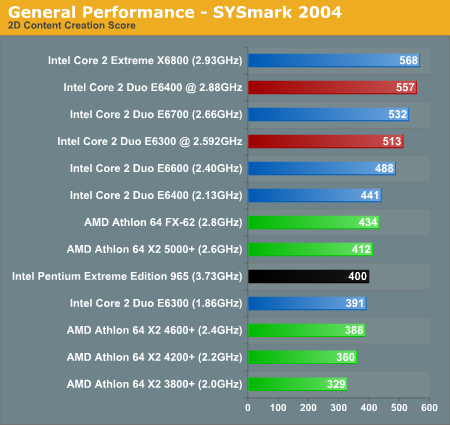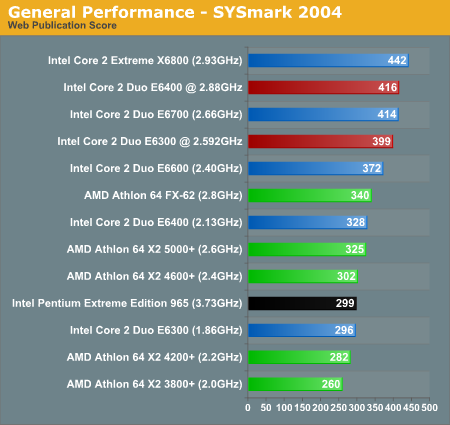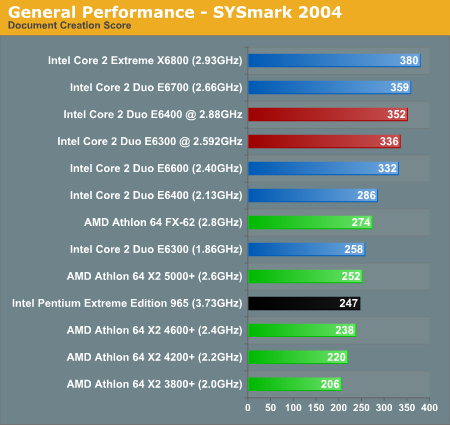Intel Core 2 Duo E6300 & E6400: Tremendous Value Through Overclocking
by Anand Lal Shimpi on July 26, 2006 8:17 AM EST- Posted in
- CPUs
Application Performance using SYSMark 2004 SE
We'll kick off our look at general application performance with SYSMark 2004 SE and as always, we'll look at the overall score as well as the scores in each of the two suites - Internet Content Creation and Office productivity.



The applications tested by SYSmark 2004 cover the vast majority of the modern computing spectrum. Everything from multimedia to office to multitasking performance is included, and while not every application will show a substantial performance increase with a faster processor, the overall performance spread among the tested CPUs is almost 75%. If you routinely do a lot of computationally intensive work on your system (surfing the web and writing email generally don't count), there's no question that you will see a substantial difference between the fastest and slowest systems we're testing.
Our first look at the E6300/E6400 with overclocking generates some interesting results. There has been speculation that one of the reasons Core 2 Duo chips perform so well is that they have so much L2 cache. Dropping from 4 MB to 2 MB of cache does hurt performance a bit, but with a little bit of overclocking both of our budget Core 2 Duo chips perform very well. The net loss appears to be about 200 MHz, so the 2.88 GHz E6400 roughly equals the 2.66 GHz E6700, and the 2.59 GHz E6300 roughly matches the 2.4 GHz E6600. Drilling down into the individual benchmark results for SYSmark 2004, the impact of the reduced cache is more apparent in Office Productivity applications than it is in the Internet Content Creation results, but the 2MB Core 2 chips preform respectably regardless of the application being tested. Perhaps a Core 2 with 1MB or less of L2 wouldn't perform all that well, but since those parts don't exist there's no reason to worry about hypothetical bottlenecks right now.
Switching over to the AMD versus Intel comparisons, the E6300 and E6400 already compete very well, and once we throw in overclocking they are basically out of reach of any of the AM2 processors -- with or without overclocking. In overall score, the overclocked E6300 is almost 20% faster than the FX-62. A 20% overclock of the FX-62 (3.33 GHz) might close the gap, but it would certainly require more than stock air cooling, and it doesn't change the fact that we are able to get extremely good performance out of Intel's $180-$220 parts.
The individual SYSMark 2004 SE scores are graphed below if you're interested; the data is used in calculating the overall scores we've already discussed above:
















137 Comments
View All Comments
getbush - Wednesday, July 26, 2006 - link
There is a for that should be four and you start the oblivion page with will instead of we'll.JarredWalton - Wednesday, July 26, 2006 - link
Thanks - I gave the document a final proofing now that I'm a bit more coherent and squashed several more "typos" (speech-recognition-os?) I helped Anand fill in a bunch of the text, but it was late and my eyes weren't cooperating. LOLyacoub - Wednesday, July 26, 2006 - link
What I see here is that the E6400 is easily the way to go for folks who aren't interested in overclocking but want the best bang-for-the-buck.For very little more $$ than the E6300, you get a chip that rides quite a bit higher up on the charts in many tests.
Now the question: What affordable motherboard is recommended for stable, reliable non-overclocked C2D Conroe performance? Perhaps the Intel P965 board?
There's no reason to drop $200-250 for a motherboard when you aren't going to utilize its overclocking functionality. I believe that opens up the user to the more affordable P965 boards, right? They tend to be more around $150 and if it's made by Intel it should be plenty stable, right?
Also most boards now are passively-cooled which is excellent since the dinky fans on older motherboards were always noisy and died quickly. Avoiding those is another benefit as I believe the Intel P965 board is passively cooled as well.
Thoughts?
anandtechrocks - Wednesday, July 26, 2006 - link
Check out the Gigabyte DS3. It uses the P965 chipset and costs ~$144. It overclocks just as well as the $250 Asus motherboard in this article and it uses very high quality solid capacitors. Only drawback is that no SLI or Crossfire.yacoub - Wednesday, July 26, 2006 - link
I don't know, looks like there's some cause for concern about currently available 965 boards now...http://forums.anandtech.com/messageview.aspx?catid...">http://forums.anandtech.com/messageview...amp;thre...
anandtechrocks - Wednesday, July 26, 2006 - link
Very good article, I really enjoyed it. I think there is an error on page 4, on the 3rd graph from the bottom. The E6300 and E6400 bars are miss-labled.JarredWalton - Wednesday, July 26, 2006 - link
Fixed - thanks.code65536 - Wednesday, July 26, 2006 - link
How do the OC'ed chips do with power consumption. Does a 6400 @ 2.88 use more or less power than a 6800, for example?supremelaw - Wednesday, July 26, 2006 - link
... and heat.I assume that the stock Intel HSF hasn't changed:
http://www.supremelaw.org/systems/heatsinks/warnin...">http://www.supremelaw.org/systems/heatsinks/warnin...
and that a superior HSF with proper backing plate
is still recommended for Conroe CPUs, even though
they run cooler in general.
Sincerely yours,
/s/ Paul Andrew Mitchell
Webmaster, Supreme Law Library
http://www.supremelaw.org/">http://www.supremelaw.org/
houe - Wednesday, July 26, 2006 - link
fp